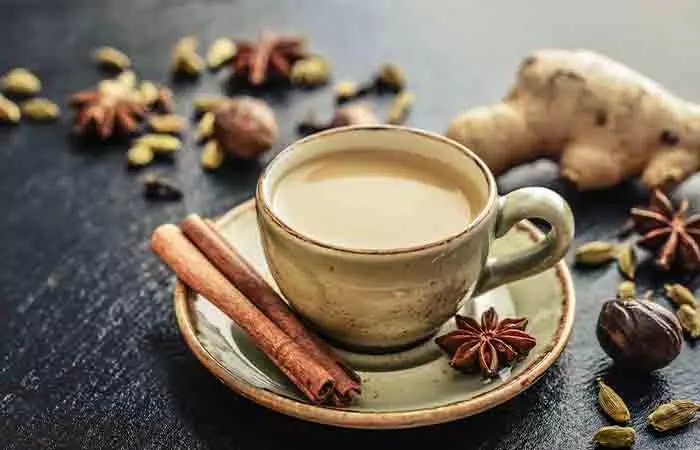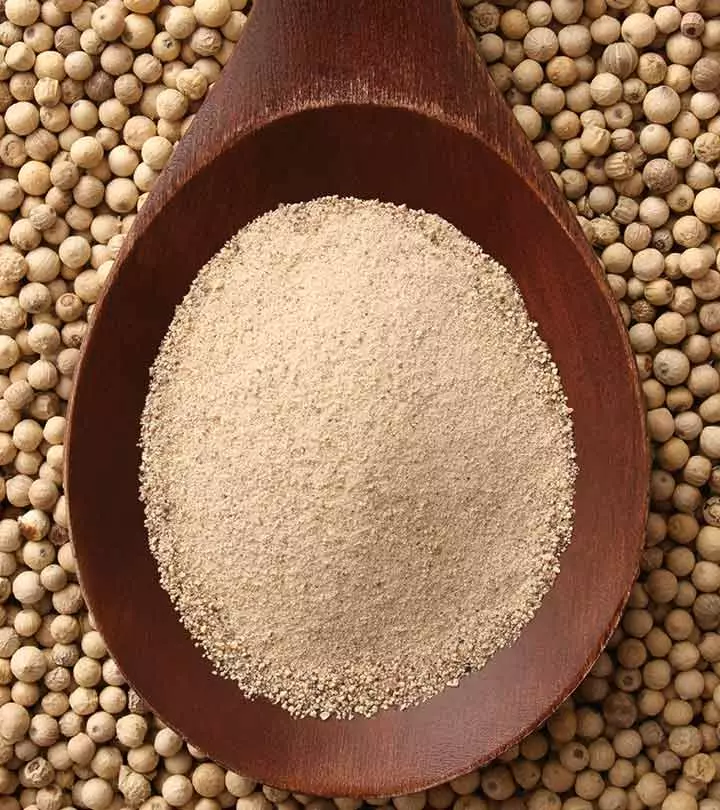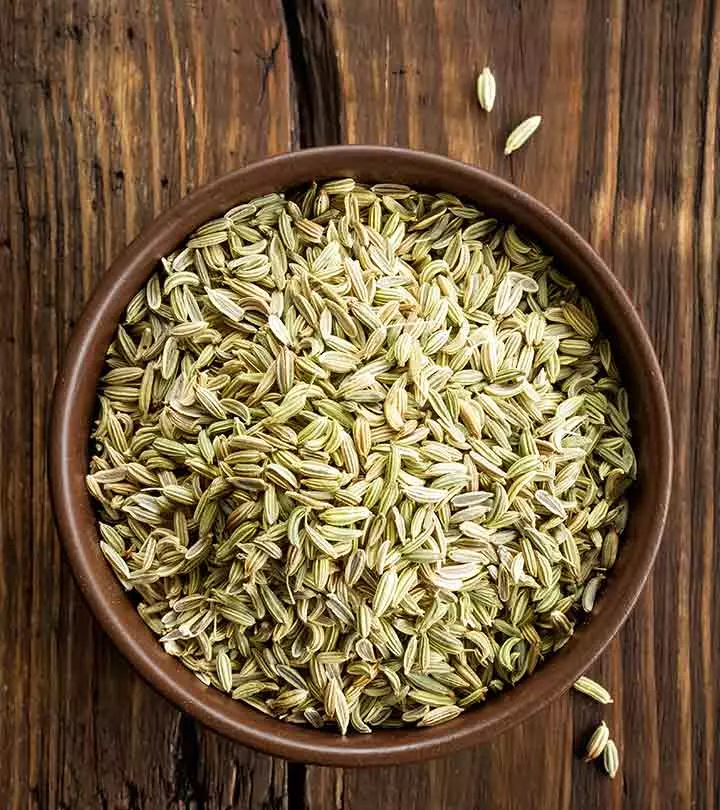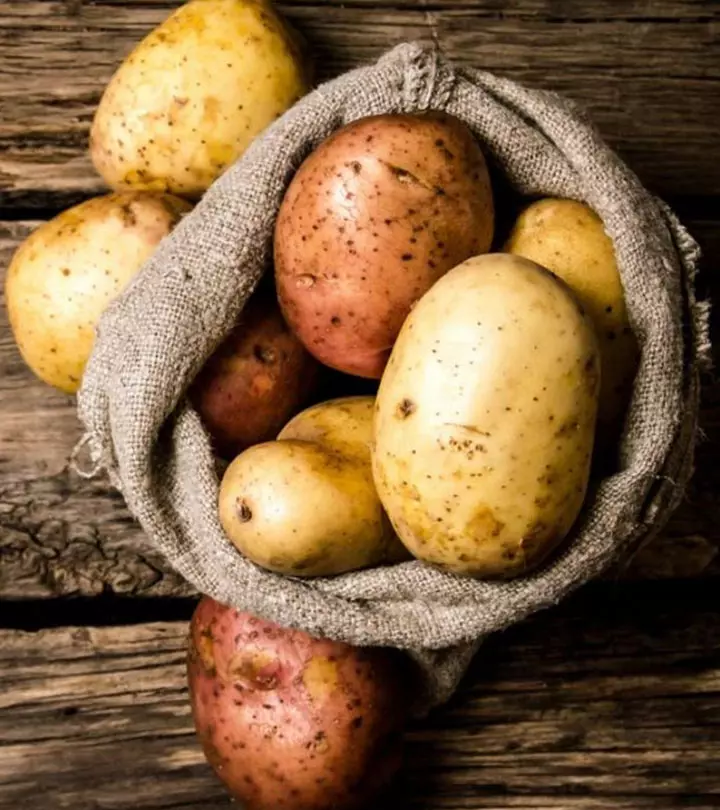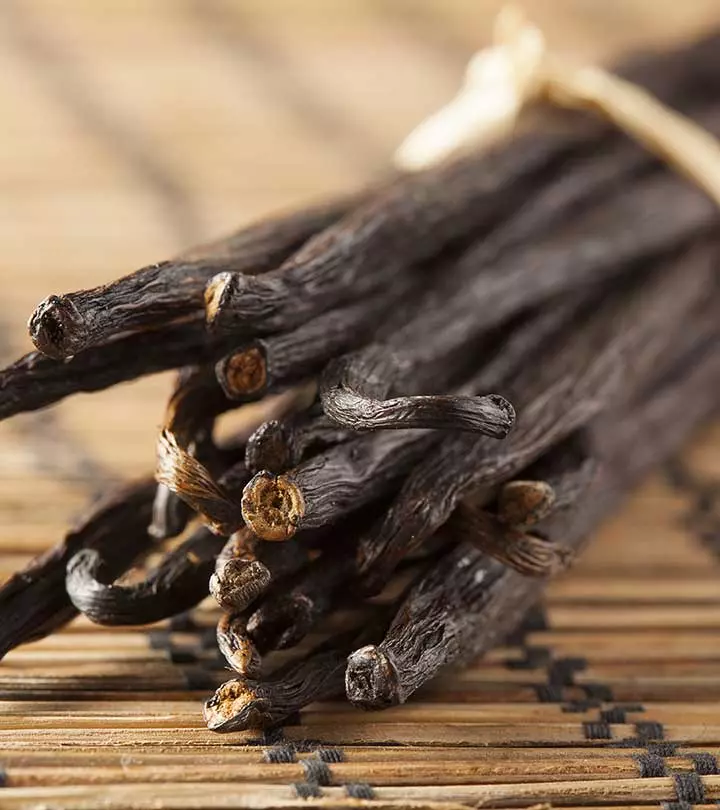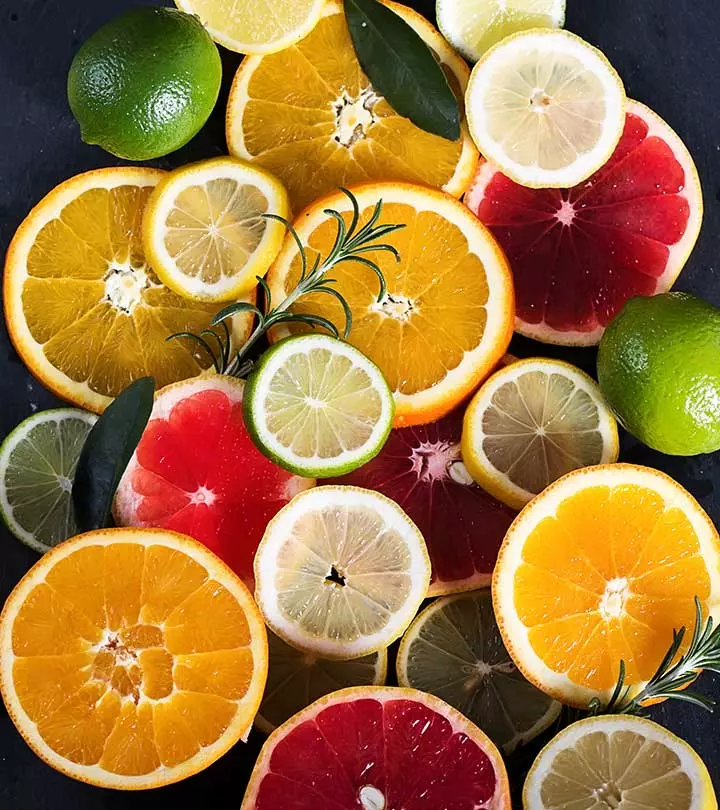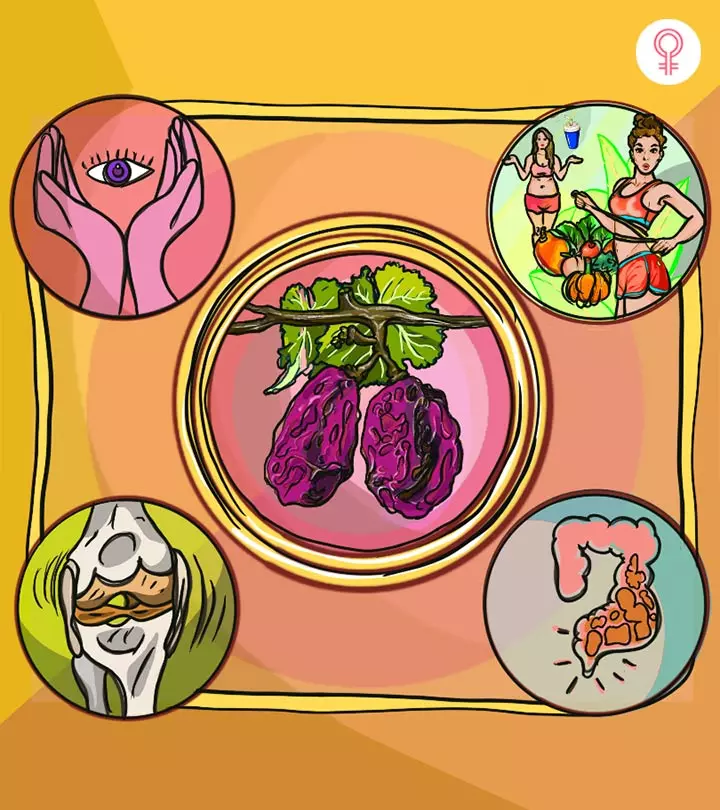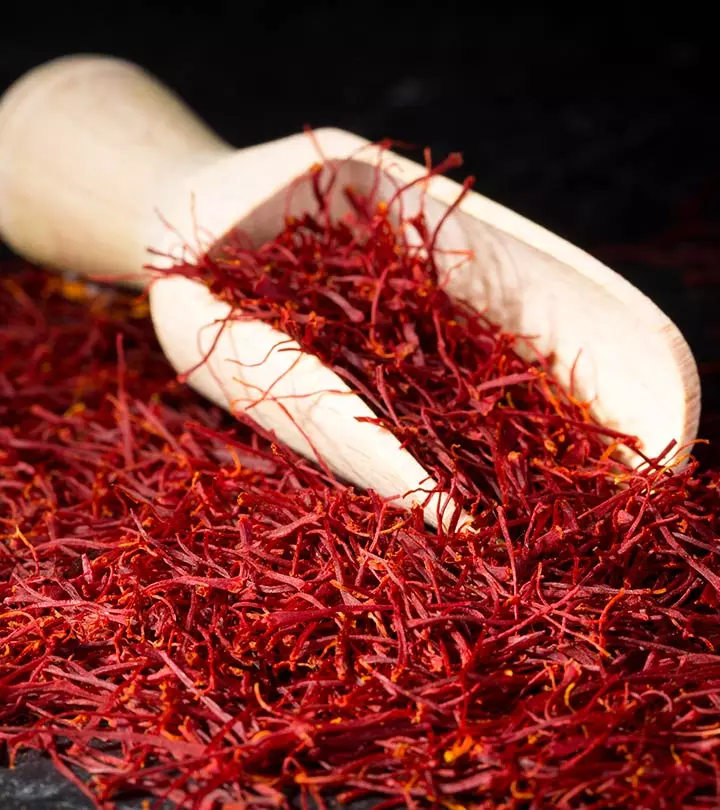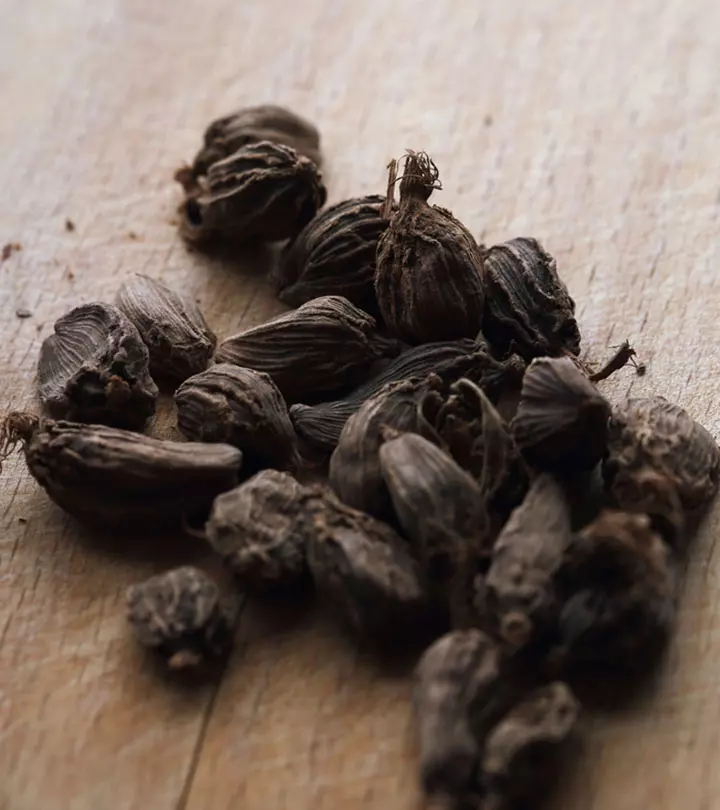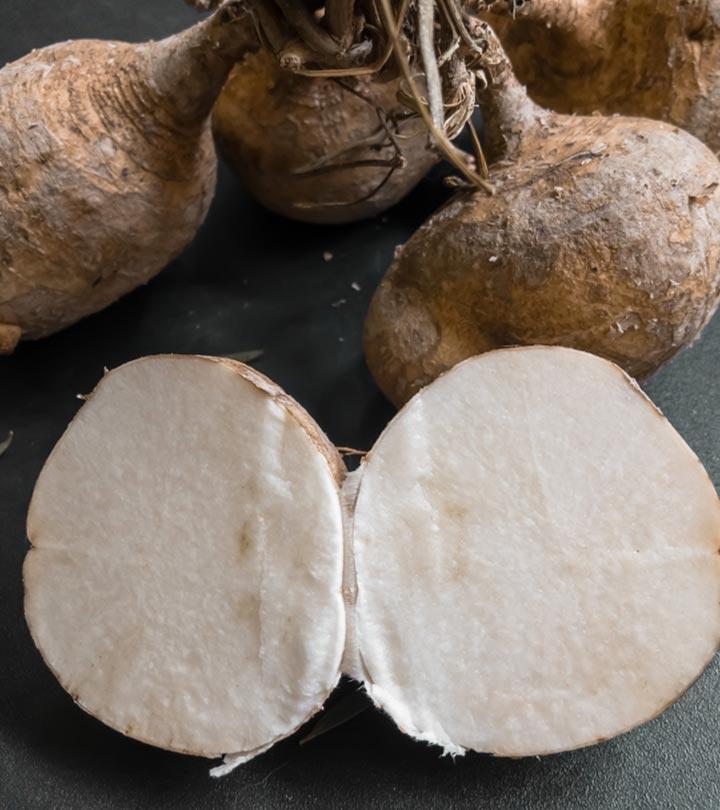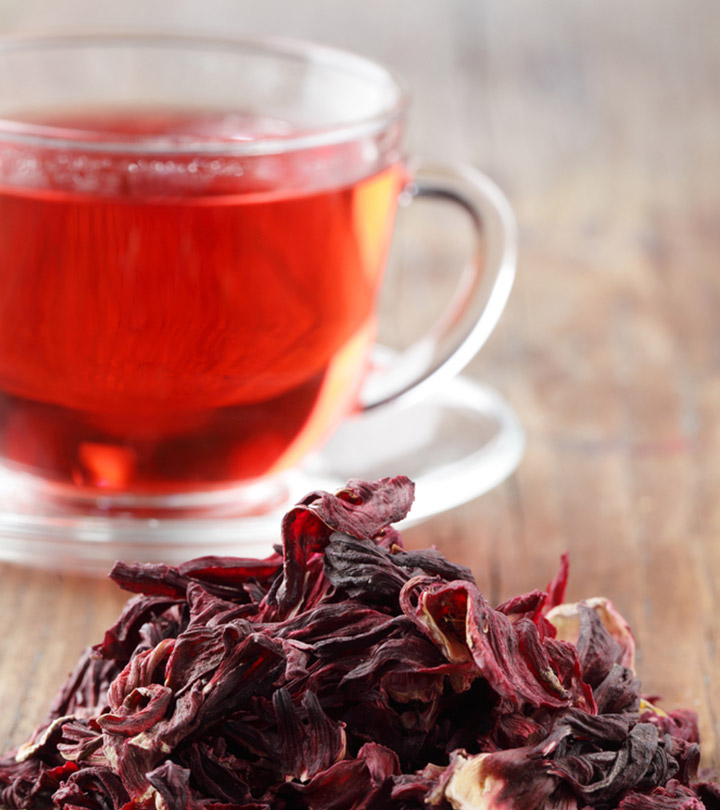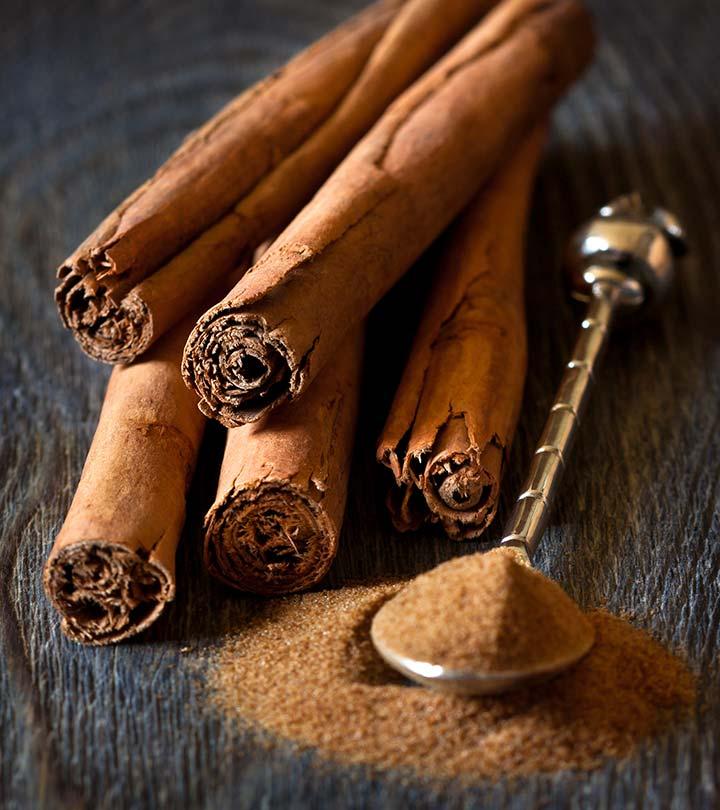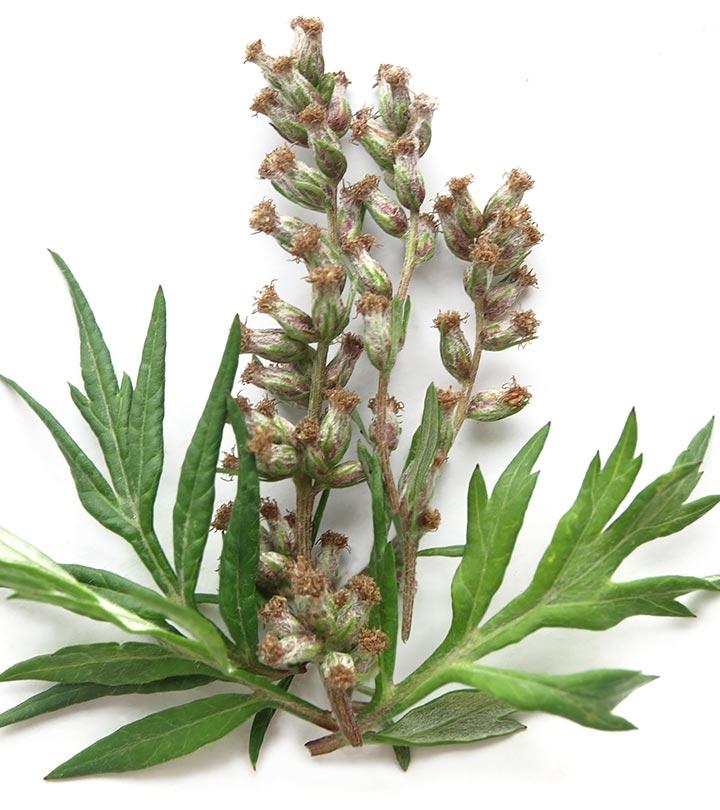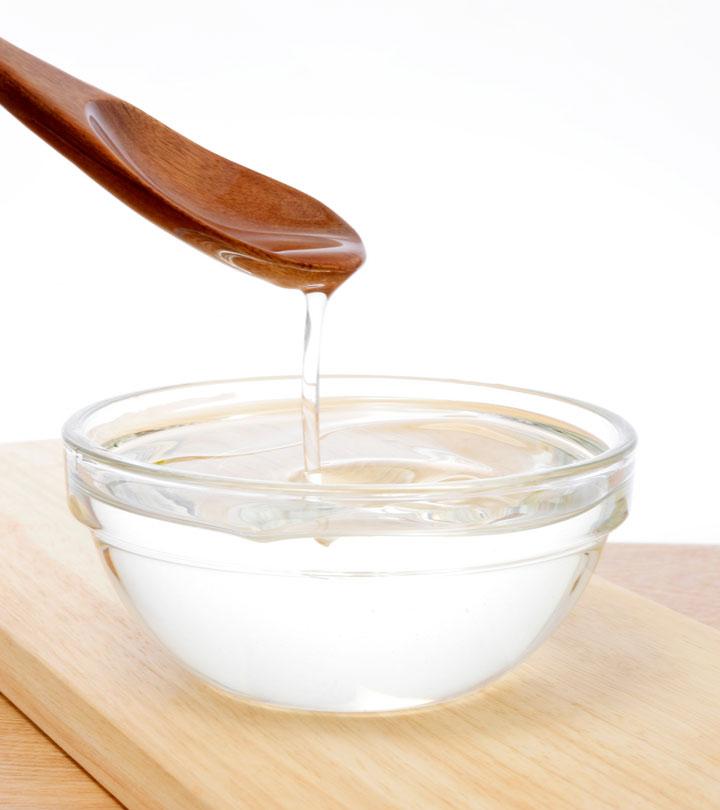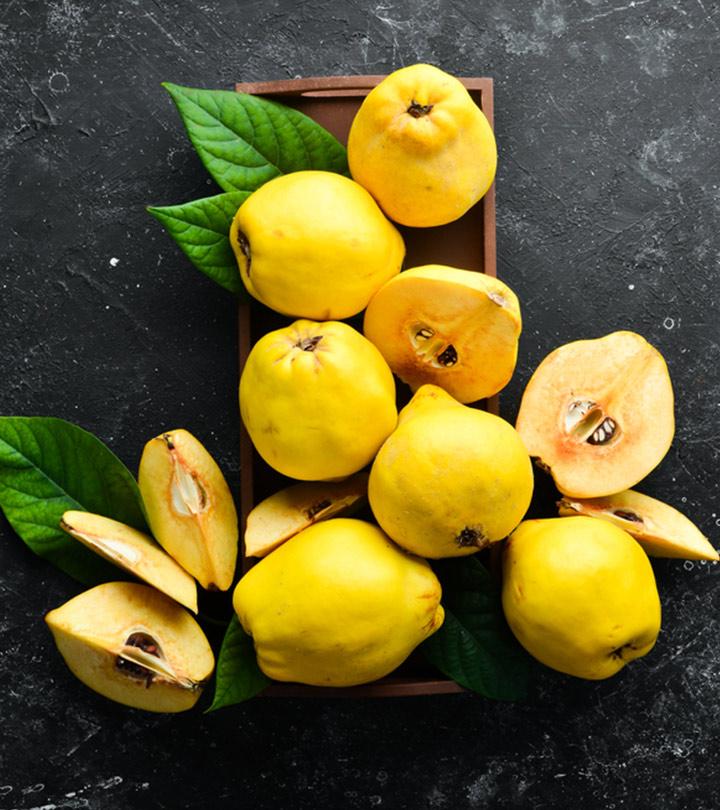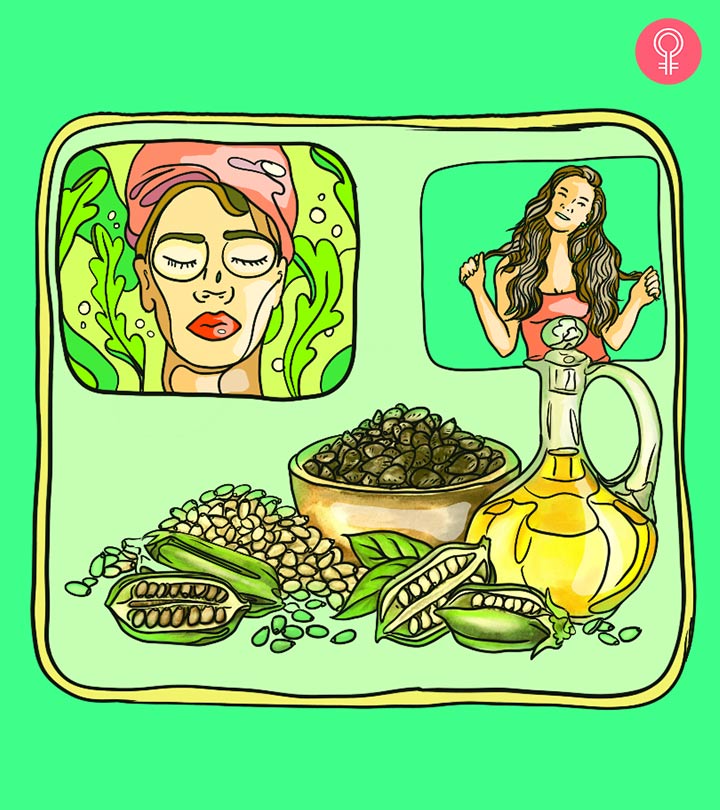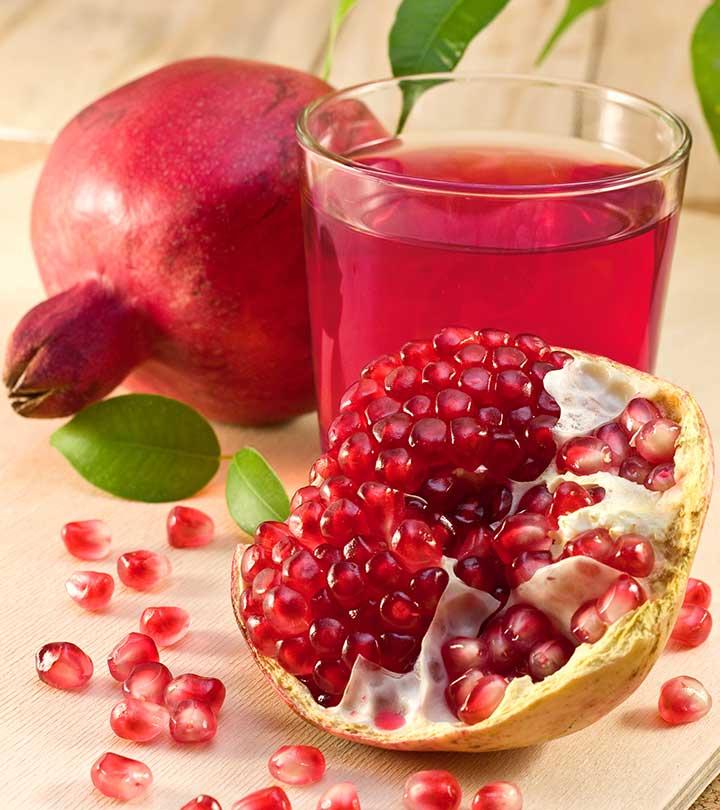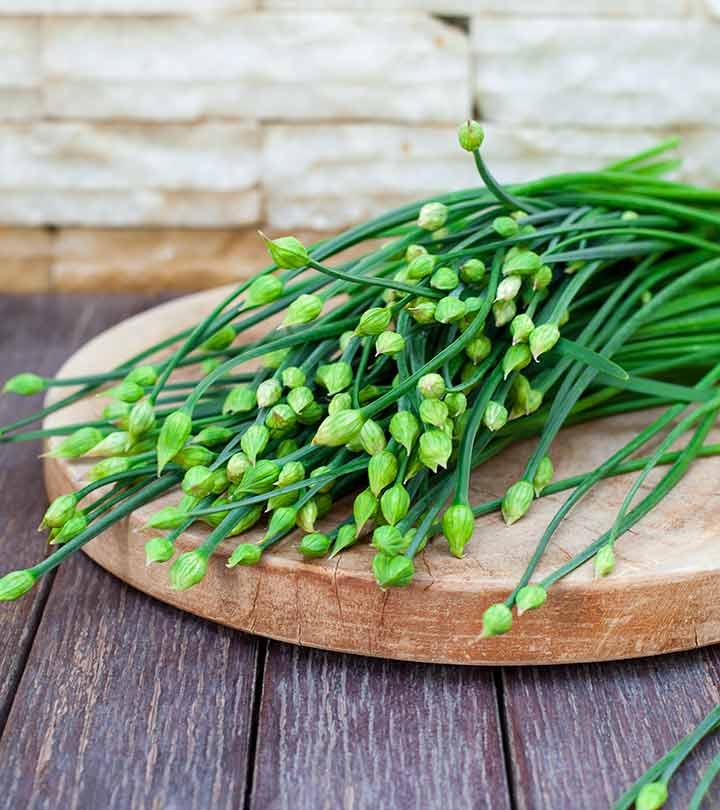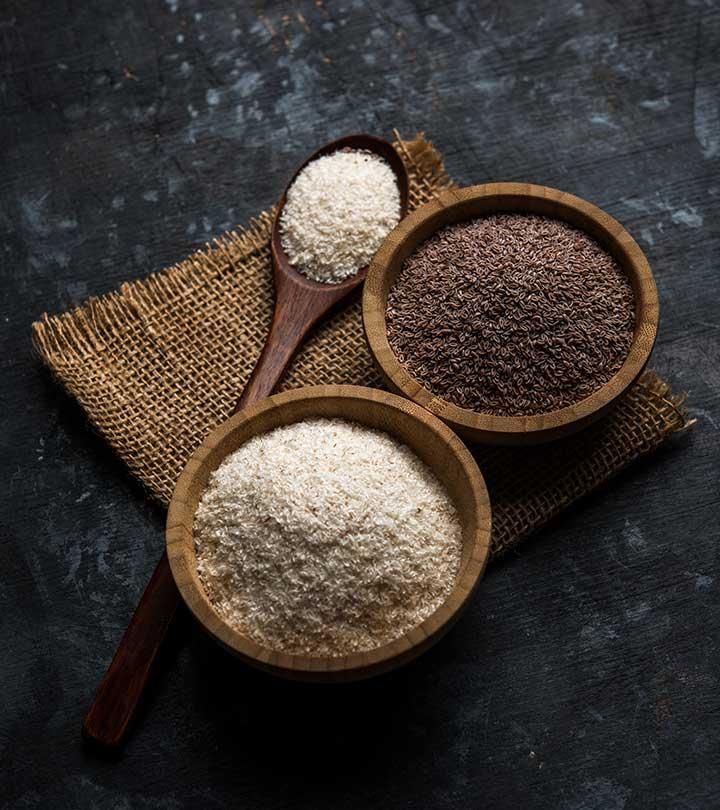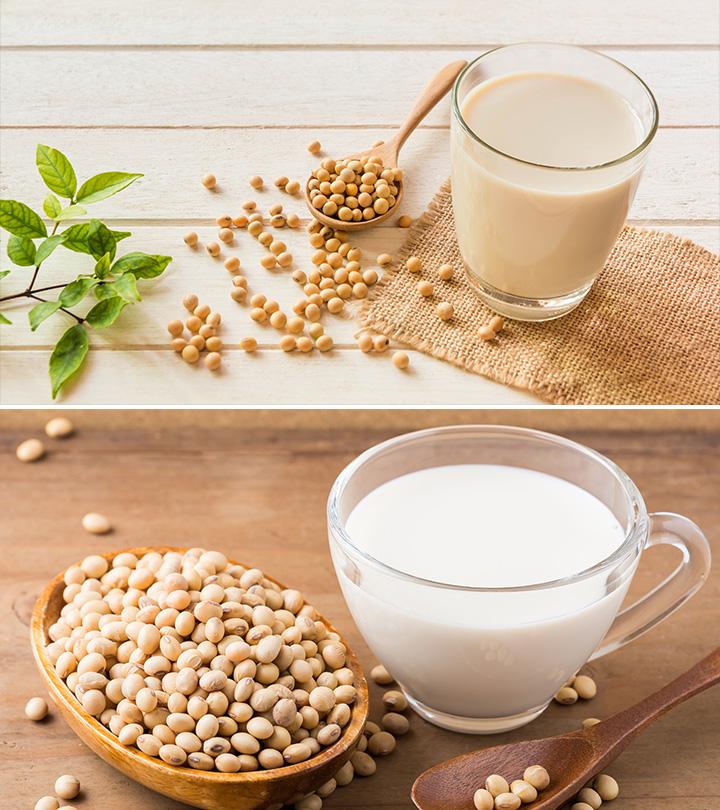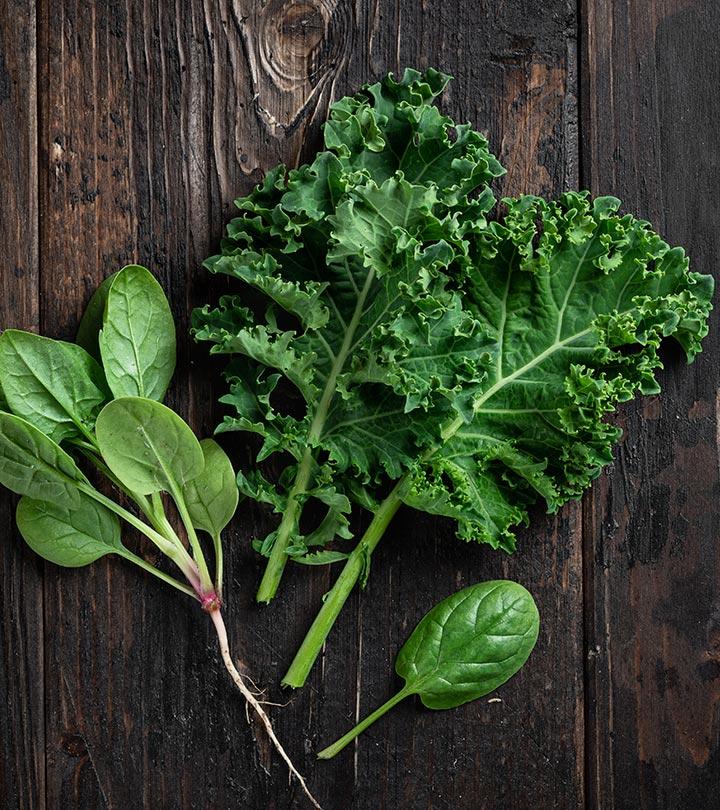24 Amazing Benefits Of Cardamom For Skin, Hair, And Health
Add a dash of flavor and boost your immunity with the therapeutic properties of this spice.

Image: Shutterstock
This spice is a regular feature in many dishes across cuisines the world over. Well, there is a reason – to make most of the amazing benefits of cardamom!
This article explores the different types of cardamom, its history, its nutritional profile, how it benefits your health, its potential side effects, how to cook and store it, and more. Read on!
 Know Your Ingredient: Cardamom
Know Your Ingredient: CardamomWhat Is It?
It is a spice used in cooking, particularly in Indian and Middle Eastern cuisines.
What are Its Benefits?
It has antioxidant and anti-inflammatory properties. It may improve digestion, reduce bad breath, and lower blood pressure.
Who Can Use It?
It is generally safe for most people to consume. Individuals with diabetes, high cholesterol, build up of fat in the liver may consume it.
How Often?
It is recommended to have 500 mg of cardamom powder or its extract once or twice a day
Caution
If you take any medications, talk to your doctor before using cardamom as a supplement or in large amounts.
In This Article
What Is Cardamom?
Popularly known as “Elaichi” in Hindi, “Aelakka” in Malayalam, “Elakkai” in Tamil, “Yelakulu” in Telugu, “Yalakki” in Kannada, “Ilaychi” in Gujarati, “Hr̥daya rōga” in Nepali and “Huba alhal” in Arabic – cardamom is a spice made from the seeds of several plants belonging to the family Zingiberaceae.
The spice is native to India, Bhutan, Nepal, and Indonesia. Cardamom pods are small (that’s how they are recognized), triangular in cross-section, and shaped as spindles.
Called the Queen of Spices, cardamom is the world’s third most expensive spice – surpassed only by saffron and vanilla. And not just that – this spice comes in different types as well.
What Are The Different Types Of Cardamom?
Green and black cardamom – the two major types.
Green cardamom, also known as true cardamom, is the commonest variety. This is distributed from India to Malaysia.
- It is used to flavor both sweet and savory dishes.
- It is also added to rich curries and milk-based preparations for its fragrance.
- Tea and coffee are also spiced with cardamom.
Black cardamom is native to the Eastern Himalayas and is mostly cultivated in Sikkim, Eastern Nepal, and parts of West Bengal in India. It is brown and slightly elongated.
- It is used only in savory dishes like curries and biryani.
- It is also an essential ingredient in garam masala (the blend of spices).
- The dark brown seeds are known for their medicinal values – particularly so because of their nutrient content (volatile oils, calcium, iron, etc.).
We also have ground cardamom – which is nothing but what we get when the spice is crushed to obtain cardamom powder.
This spice does have an interesting history.
What Is The History Of Cardamom?
The use of cardamom dates back to at least 4,000 years. Considered one of the world’s oldest spices, it was used in ancient Egypt as a traditional medicine because of its medicinal properties – and even as a part of rituals and embalming. And the Romans and Greeks used this spice for its pungent aroma. The Vikings discovered it during their travels and brought it back to Scandinavia.
As of today, Guatemala is the largest producer of this spice in the world.
The spice is believed to have originally come from the Western Ghats in Southern India.
All of this is not as important as what is inside cardamom – the nutrients that make it what it is today.
What Is The Nutritional Profile Of Cardamom?
| Principle | Nutrient Value | Percentage of RDA |
|---|---|---|
| Energy | 311 Kcal | 15.5% |
| Carbohydrates | 68.47 g | 52.5% |
| Protein | 10.76 g | 19% |
| Total Fat | 6.7 g | 23% |
| Cholesterol | 0 mg | 0% |
| Dietary Fiber | 28 g | 70% |
| Vitamins | ||
| Niacin | 1.102 mg | 7% |
| Pyridoxine | 0.230 mg | 18% |
| Riboflavin | 0.182 mg | 14% |
| Thiamin | 0.198 mg | 16.5% |
| Vitamin A | 0 IU | 0% |
| Vitamin C | 21 mg | 35% |
| Electrolytes | ||
| Sodium | 18 mg | 1% |
| Potassium | 1119 mg | 24% |
| Minerals | ||
| Calcium | 383 mg | 38% |
| Copper | 0.383 mg | 42.5% |
| Iron | 13.97 mg | 175% |
| Magnesium | 229 mg | 57% |
| Manganese | 28 mg | 1217% |
| Phosphorus | 178 mg | 25% |
| Zinc | 7.47 mg | 68% |
Pallini Winnifred, RDN, says, “Cardamom is a spice that is commonly used in cooking and is generally considered safe to consume in normal amounts. It is not necessary to consume cardamom daily, and there is no specific recommended daily intake for this spice.”
And now, we head to the benefits.
What Are The Health Benefits Of Cardamom?
Cardamom helps improve digestive health and prevents certain serious ailments like cancer. It also aids in diabetes treatment and helps you cope with depression. You can include cardamom in your diet as you usually do or even take cardamom milk (also called elaichi milk) to avail the wondrous benefits.
1. Improves Digestive Health
According to an Indian study, cardamom can be used in cuisines not just for flavor, but also for enhancing digestion (1). The spice also stimulates metabolism, given its antioxidant and anti-inflammatory properties (2).
Cardamom is also known to stimulate the secretion of bile acid in the stomach, further aiding in digestion and weight loss, and proper fat metabolism (3). The spice also prevents other gastrointestinal ailments like acid reflux, heartburn, diarrhea, etc.
Tom Miller, Certified Personal Trainer, says, “Drinking excessive amounts of tea or coffee might make you acidic. However, adding this spice to your tea or coffee will mitigate the acidity. Adding cardamom to your tea transforms it into the king of chai. Simply add cardamom powder to your tea leaves as they boil.”
2. Promotes Heart Health
Its antioxidant properties can promote heart health. Cardamom also contains fiber, the nutrient that can help lower cholesterol levels and enhance heart health.
The spice also can lower blood pressure levels – and this benefits the heart. Simply have a concoction of a teaspoon of coriander and a pinch of cardamom along with a cup of freshly squeezed peach juice.
Black cardamom seems to work much better than its green cousin when it comes to heart health. One study conducted on patients with ischemic heart disease had their plasma lipid profiles and antioxidant status and fibrinolytic activity (a process that prevents blood clots from growing and causing problems) getting better post the ingestion of black cardamom (4).
As per a report by the Harvard Medical School, cardamom is one of the ingredients heart experts usually include in their dinners (5).
3. Aids In Cancer Prevention
Cardamom has exhibited its potential as a natural cancer treatment. Several animal studies have shown that the spice can be used to prevent, delay, and even reverse cancer formation.
As per one Saudi Arabian study, administration of cardamom powder had reduced the occurrence of tumors (6). Cardamom also decreases general inflammation, which inhibits the growth of cancer cells and encourages their death. Another Saudi Arabian study states that cardamom has the potential to treat forestomach cancer.
The spice had also shown desirable effects on chemically induced colorectal cancer in mice (7).
4. Has Diuretic Properties
Cardamom has diuretic properties that can benefit cases of hypertensioni A condition in which the force of blood against the walls of arteries is above normal, causing high blood pressure. , heart failure, and epilepsyi Seizures or episodes of unusual behavior that often cause loss of awareness due to abnormal brain activity. (8). These diuretic properties of cardamom also aid in detoxification.
5. Helps Fight Depression
According to a health report, cardamom can indeed help people cope with depression. Just powder a few seeds of cardamom and boil them in water along with your everyday tea. Take the tea regularly for better results (9).
6. Fights Asthma
Cardamom plays a role in fighting asthma symptoms like wheezing, coughing, shortness of breath, and tightness in the chest. The spice makes breathing easier by enhancing blood circulation within the lungs. It also fights related inflammation by soothing the mucus membranes.
Another report says that green cardamom can be used to treat asthma, bronchitisi Inflammation of the lining of the bronchial tubes that carries air to and from the lungs, which causes coughing and shortness of breath. , and numerous other respiratory issues (10).
7. Aids In Diabetes Treatment
Cardamom is extremely rich in manganese – a mineral that can lower the risk of diabetes. However, a lot more research is required in this aspect.
8. Improves Oral Health
Cardamom possesses antimicrobial properties that enhance oral health. Cardamom can protect against oral pathogens like Streptococci mutans (11). The pungent taste of cardamom even stimulates the salivary flow – and this can help prevent dental caries.
Cardamom can also work well in treating bad breath. Especially when you take a mixture of spices, including the seeds of anise, cardamom, and fennel – bad breath wouldn’t be a problem anymore (12).
 Did You Know?
Did You Know?9. Enhances Appetite
One Polish study emphasizes on the use of cardamom for treating a lack of appetite (13). Even cardamom oil can be used as an appetite stimulant (14).
Cardamom can also aid in the treatment of histoplasmosis – a condition in which one of the symptoms is a lack of appetite (15).
10. Lowers Blood Pressure Levels
According to an Indian study, cardamom effectively lowers blood pressure (16). You can simply include cardamom in your soups and stews or even baked items to keep your blood pressure levels in check.
11. Improves Sexual Health
Cardamom is a proven aphrodisiac. The spice is rich in a compound called cineole, and just a small pinch of cardamom powder can release nerve stimulants and fuel your passions.
Some reports say that cardamom can also treat impotence. Further research is warranted.
12. Can Treat Hiccups
Cardamom has muscle-relaxing properties, and these can help relieve hiccups. All you need to do is add a teaspoon of cardamom powder to hot water. Let it steep for about 15 minutes. Strain and consume slowly.
13. Helps Treat Sore Throat
A mixture of cardamom, cinnamon, and black pepper can work wonders for treating a sore throat. While cardamom soothes the sore throat and reduces irritation, cinnamon offers antibacterial protection. And black pepper improves the bioavailability of the two ingredients. You can take 1 gram each of cardamom and cinnamon powders, 125 mg of black pepper, along with 1 teaspoon of honey. Mix all ingredients and lick the mixture thrice a day.
Cardamom also has been found to reduce nauseai An uneasy feeling in the stomach that is accompanied by an urge to vomit but does not always lead to vomiting. and prevent vomiting. In one study, test subjects who were given cardamom powder showed less frequency and duration of nausea and less frequency of vomiting.
14. Prevents Blood Clots
According to the Central Food Technological Research Institute in India, cardamom contains several components that relieve blood clots. But yes, adequate research is lacking in this aspect.
What Are The Benefits For The Skin?
The skin benefits of cardamom can be attributed to its antibacterial and antioxidant properties. The spice helps treat skin allergies and improves skin complexion. It can also be used as a tool to cleanse the skin.
15. Improves Complexion
One of the benefits of elaichi, or cardamom, is that it can give you fair skin. Cardamom essential oil helps in removing blemishes, thus giving you a fairer complexion.
You can either buy skin care products containing cardamom or its essential oil. Or you can simply mix cardamom powder with honey and apply it as a face mask.
16. Improves Blood Circulation
Cardamom contains vitamin C, which is a powerful antioxidant. It improves blood circulation throughout the body. Also, the many layers of phytonutrientsi Chemical compounds found in plants that help them resist fungi and bacteria and contain essential vitamins, minerals, and fibers. in the spice can improve blood circulation – which invariably enhances skin health.
17. Treats Skin Allergies
Cardamom, especially the black variety, has antibacterial properties. Applying a cardamom and honey mask (a mixture of cardamom powder and honey) to the affected area can give relief.
18. Imparts Fragrance
Cardamom is often used in cosmetics to impart fragrance. Due to its distinct spicy, sweet scent, both cardamom and cardamom oil are used in perfumes, soaps, body washes, powders, and other cosmetics. Oriental style perfumes and other scented products often use cardamom as an ingredient in addition to other essential oils.
19. Offers Therapeutic Benefits To The Skin
Cardamom can be used in skin care products for antiseptic and anti-inflammatory purposes to calm and soothe the skin, thanks to its therapeutic effects. When added to perfumes, it can stimulate the senses. Facial soaps use cardamom to impart a warming sensation to the skin.These cosmetics using cardamom for therapeutic reasons are known as aromatherapy products.
20. Works As A Great Masking Agent
The strong scent of cardamom can ward off unpleasant odors. This makes it a great addition to cosmetic products, such as toners, that serve a specific function but smell unappealing due to the inclusion of certain ingredients. Cardamom is added to these products to mask the unpleasant scent while retaining the benefit of the cosmetic.
21. Offers Lip Care
Cardamom essential oil is often added to cosmetics that are applied to the lips (such as lip balms) to impart the taste of the oil and make the lips smooth.
You can simply apply the oil to your skin before you go to bed and wash it off in the morning.
22. Helps You Achieve Clear Skin
Black cardamom helps in flushing out the toxins that could otherwise harm your skin. Chewing some black cardamom detoxifies your body, thus providing you with clearer skin.
What About The Benefits For Hair?
Cardamom can contribute to improved hair growth and the treatment of certain scalp issues.
23. Nourishes Your Scalp
The antioxidant properties of cardamom, and especially the black type, nourish your scalp and improve its health. The spice also nourishes the hair follicles and enhances hair strength. You can wash your hair with cardamom water (mix the powder with water and use before shampoo) to achieve the desired results.
The antibacterial properties of the spice even treat scalp infections, if any.
24. Improves Hair Health
This is a given. Improved scalp health most often means stronger and better-looking hair. The spice strengthens your hair roots and offers shine and luster to your hair.
These were the benefits. A simple spice can transform your health, provided you take it on a regular basis. And now, we have an important question to address – what is the difference between cardamom and coriander? Firstly, why should we care about such a comparison?
Cardamom Vs. Coriander – What’s With The Comparison?
The two are spices with similar benefits (which is why we are interested in this comparison). Like, say, the two are used to treat high blood sugar, high blood pressure, and other digestive issues. Also, cardamom and coriander are two of the five digestive spices mentioned in Ayurveda. The other three are cumin, ginger, and fennel.
But there are a few factors on which the two spices differ.
| Cardamom | Coriander |
| Made from the seed pods of plants in the ginger family | Comes from the seeds of the cilantro plant |
| Is considered a warming spice | Is considered a cooling spice |
| Is native to Southern Asia and India | Is native to the Mediterranean and parts of Southern Europe |
| Guatemala is the largest producer as of today | India is the largest producer as of today |
| Used as a remedy for bad breath and asthma | Used to prevent food poisoning |
Alright. Now that you are convinced cardamom has excellent benefits, how do you use the spice in cooking?
How To Use Cardamom In Cooking?
Cardamom is one of the most prized spices all over the world. It can be used in the whole as well as ground form in a variety of dishes ranging from curry powders, dals, and masalas to desserts and drinks. While cooking the seeds, they should be bruised with the back of a knife or ground with other spices before frying. Given below are the tips for the usage of cardamom as an ingredient.
- In India, cardamom is one of the main constituents of garam masala, a combination of spices used in both vegetarian and non-vegetarian dishes. It is also an important ingredient in the preparation of curry powder commonly used in Indian cooking.
- Cardamom can be added to tea or coffee to impart its pleasant and refreshing aroma. You can add some cardamom to your ground coffee before brewing and then sweeten and top with cream.
- Whole green cardamom pods are added to pulaos, curries, and hot dishes. As the shell integrates while cooking, it infuses the dish with its essence and refreshing aroma. Thus, it is often used to impart aroma to biryanis, pulaos, and kebabs.
- Besides the savory dishes, cardamom can be used in desserts like kheer and firni as well as sweets like gulab jamun, gajar ka halwa, etc. to impart its distinctive flavor. In Scandinavian countries, it is used for flavoring all types of sweet pastry and bread dishes instead of cinnamon.
- Ground cardamom seeds can be used to flavor foods like soups, pates, stews, purees, and rice dishes. You can try adding some seeds to your homemade rice pudding, ice cream, custard, or sprinkle them over a fresh fruit salad.
- Chicken can be marinated in honey, cardamom, and pepper. It can then be roasted on the stove top and baked to prepare the delicious cardamom honey chicken.
- You can prepare a citrus fruit salad consisting of citrus fruits such as grapefruit and oranges, sweeten it with honey, and season it with lime juice and cardamom.
- Swedish coffee bread is slightly sweet yeast bread. It is generally flavored with cardamom and braided or made into a wreath-shaped pastry.
- Lemons can be preserved in cardamom. These can be then used in a variety of dishes.
- Cut the lemons lengthwise into quarters, leaving the stem attached.
- Rub their flesh with some kosher salt and put one tablespoon of salt at the bottom of a glass jar.
- Place these lemon quarters in this jar alternating with salt, cardamom pods, and bay leaves.
- Pour in some juice that is enough to cover the lemons and cover tightly. Allow the mixture to stand for about 3 weeks,
- Keep shaking the jar daily to mix the salt. These preserved lemons can be refrigerated for up to 6 months covered with lemon juice.
- Lassi is a refreshing drink rather popular in India. Cardamom powder can be added to lassi to provide it with a distinct taste. You can prepare it by combining curd, full-fat milk, powdered sugar, and cardamom powder, and blending these ingredients in a mixer for 2 to 3 minutes. Serve it in glasses after adding sugar cubes. You can also garnish lassi with cardamom powder and chopped dry fruits.
- Indian style basmati rice is a savory dish that is flavored with whole spices, including cardamom.
- All you need to do is put some rice in a bowl, adding enough water to cover it.
- Heat some oil in a saucepan over medium heat and add cinnamon sticks, cardamom pods, cloves, and cumin seeds.
- After cooking for about a minute, add some chopped onion. Sauté it until golden brown for about 10 minutes.
- Drain the water from the rice, and cook and stir the pot for a few minutes. Add salt and water. Simmer for about 15 minutes at low heat until all the water has been absorbed.
- Allow it to stand for 5 minutes and fluff with a fork before serving. It can be served with curry or dal (lentils).
A blogger shares her experience of using cardamom in her recipes: “I like to saute them in oil with cloves and cinnamon and then simmer them with basmati rice to produce a delicious pilaf (i).” While she recommends powdering cardamom in a mortar and pestle instead of a spice grinder, she adds, “Like my mom, I don’t bother to remove the papery pods. They powder easily and do not affect the flavor or texture of the spice mix.”
 Trivia
TriviaThat’s the different ways you can use cardamom in your cooking. But even before you do that, you need to first select and store the spice, right?
How are you going to do that?
How To Select And Store Cardamom
Selection
Both ground and loose seeds of cardamom are available in the spice section of the supermarkets while whole pods are available in specialty stores.
- When buying cardamom, always prefer the green one as it has a complex flavor that is suitable for both sweet and savory dishes. Moreover, whole cardamom pods should be chosen over ground ones. Look for small football-shaped pods having a green tint. They should smell like a combination of pine and flowers.
- If ground cardamom is needed, it is advisable to grind the seeds from a whole pod with a mortar and pestle or spice grinder. However, ground cardamom loses its flavor rapidly while the whole spice stays potent for a year or even longer.
Cardamom is an expensive spice, and so, other spices are often added to ground cardamom to reduce the cost. The opening of the pods or the grinding of the seeds causes a quick loss of the flavor and aroma of the cardamom due to the rapid loss of the essential oils.
Storage
Proper storage of cardamom is of prime importance to retain its taste and aroma and extend its shelf life.
- The best way is to store cardamom in the form of pods because once the seeds are exposed or ground, they lose their flavor and aroma rapidly.
- Cardamom pods can last up to a year when stored in an airtight container in a cool, dry place.
- Dry cardamom capsules should be kept in moisture-proof containers away from direct sunlight.
- For bulk storage on a long-term basis, the pods should be kept in polythene lined gunny bags inside wooden boxes. This will preserve the green color of the pods. Before placing the capsule in the gunny bags for storage, ensure that they are fully dry. Any moisture in the bag will cause them to rot. Moreover, they should be inspected regularly for signs of moisture or spoilage.
- The storage room should be dark, dry, clean, cool, and free from pests. To protect the pods from pests and insects, mosquito nettings should be fitted on the windows. They should be kept away from strong smelling food, detergents, and paints as they will spoil the delicate aroma of cardamom.
Okay. Now you know how to pick the right kind of cardamom and store it properly. How about using the spice in some delectable recipes?
What Recipes Can You Use Cardamom In?
1. Cardamom Spiced Tea
What You Need
- 1 teaspoon of ground ginger
- 1/2 teaspoon of ground cardamom
- 1/8 teaspoon each of ground cloves and black pepper
- 1 cinnamon stick
- 2 1/2 cups of water
- 2 black tea bags
- 2 1/2 cups of low-fat milk
- 2 tablespoons of honey
- 2 tablespoons of orange zest, for garnish
Directions
- In a small bowl, combine the ginger, cardamom, cloves, and black pepper. Set aside.
- Fill a saucepan with water and bring it to a full boil. Place the tea bags and cinnamon stick in the water. Stir in the spice mixture and reduce to simmer.
- Steep for about 5 minutes for a rich tea flavor.
- Remove the tea bags and cinnamon stick.
- Add the milk and honey. Continue to simmer until the tea is heated enough. Keep stirring gently to keep the scum from forming on the milk.
- Pour the tea into mugs and sprinkle with orange zest.
2. Cardamom Honey Chicken
What You Need
For the marinade
- 4 tablespoons of honey
- 2 tablespoons of sherry
- 1 teaspoon each of ground cardamom seeds and ground peppercorn
For the chicken
- 1 whole chicken cut into parts
- 2 tablespoons of olive oil
- 1 thinly sliced lemon
- Salt and pepper
Directions
- For marinating the chicken, slightly warm the honey and stir in the shrerry, cardamom, and peppercorn. Place the marinade and chicken in a large bowl and coat the chicken with the marinade. Cover the bowl with a plastic wrap and let it sit for about 30 minutes (at room temperature).
- Preheat the oven to 390o F.
- Heat the olive oil at medium heat in a large frying pan. Sear the chicken for about 30 seconds until it turns golden.
- Now, place the lemon slices in a roasting pan and lay the chicken pieces on the top. Brush them with the marinade. Season with salt and pepper. Cover with the foil.
- Place in the oven and bake for about 30 minutes. Remove the foil and continue to bake for 15 more minutes. In case the chicken gets too dark, tent with the foil.
- Remove from the oven and let it rest for 10 minutes.
- Serve with mashed potatoes or rice.
The recipes are great for sure. But the facts about cardamom give you an entirely new perspective about the spice.
Any Cool Facts About This Spice?
- Cardamom was first introduced to Guatemala in 1914, and today, it is the largest producer of the spice.
- Cardamom, turmeric, and ginger belong to the same botanical family (Zingiberaceae).
- You don’t have to really discard the cardamom pods (the green covers). You can use them as they are.
- White cardamom is not a variety of cardamom, but just the green ones bleached.
Wondering where to buy this spice?
Where To Buy Cardamom?
Your nearest supermarket is the best place.
Cardamom is wonderfully nutritious. But it is important to know of its other side too – the not-so-appealing one.
Does Cardamom Have Any Side Effects?
Jesse Feder, Clinical Dietitian at the Memorial Regional Hospital South, says, “Too much cardamom can lead to non-lethal side effects, such as loose stools, gas, cramping, nausea, and vomiting. Some people have claimed they developed gallstones from eating too much of it.”
Yes. Cardamom has side effects, and they are discussed below.
- Issues With Pregnancy And Breastfeeding
Though taking cardamom in normal amounts is safe, taking the spice as a medicine might have some undesirable effects. Stay safe and consume it only in food amounts. Or avoid use altogether.
- Gallstone Colic
If you have gallstones, avoid intake. Cardamom seed is known to trigger gallstone colic.
If cardamon does not suit you, check out the next section for suitable alternatives you can incorporate into your daily diet.
What Spice Is Similar To Cardamom?
- Cinnamon And Cloves: A combination of ground cinnamon and cloves somewhat mimics the sweet-spicy and warm notes of cardamom. You may use this blend in both sweet and savory recipes.
- Nutmeg: It has a warm, nutty, and slightly sweet flavor that is close to cardamom’s taste. You may use it in your dessert recipes.
When using either of these spices, start with half the amount than the original recipe requires. This will help you adjust the quantity to match your taste.
Infographic: Top Health Benefits Of Cardamom
Cardamom is a spice better known for its medicinal properties. It contains many essential vitamins and minerals that are useful for proper body functioning.While we have covered all the benefits of cardamom in the article, you must be aware of a few important health benefits of this spice. Check out the infographic below to learn about the top health benefits of cardamom. Illustration: StyleCraze Design Team
Cardamom is a spice known for its flavor and medicinal properties. It is available in different varieties and is densely packed with many essential nutrients. The antioxidant, anti-inflammatory, and antibacterial properties of cardamom benefit your health in multiple ways. The consumption of cardamom may improve digestive health, promote heart health, act against cancer cells, lower blood pressure, fight depression, and aid in diabetes treatment. In addition, it may improve complexion, enhance blood circulation, and treat scalp infections. However, excess consumption of this spicy herb may cause side effects, like gallstones. Hence, limit their consumption and consult your doctor in case of emergencies.
Frequently Asked Questions
What is a good substitute for black cardamom?
As obvious it may sound, it is green cardamom. But the green variety lacks the smoky and hot flavor.
What are the benefits of drinking boiled cardamom water?
It would be most effective in calming nausea and vomiting. And, it offers the other benefits too. Gargling with the water can help ease a sore throat.
Can we eat cardamom daily?
Yes, you can consume cardamom daily in moderate amounts unless you are pregnant or otherwise instructed by your doctor.
Does cardamom help you sleep?
Cardamom extract has been shown to have a sedative effect on mice (8). This opens up the possibility that cardamom may aid sleep in humans as well.
Is cardamom good for the thyroid?
Yes, cardamom has antioxidant properties, which may help reduce the oxidative stress associated with thyroid treatments and lower the inflammation associated with thyroid dysfunction (17).
Is it OK to chew cardamom pods?
Yes, you can chew on cardamom pods. However, as the outer layering is fibrous, you may find the texture unappealing.
Key Takeaways
- The antioxidant and anti-inflammatory properties of cardamom aids digestion through improved metabolism, secretion of bile acid, and reduction of acid reflux and heartburn.
- Cardamom has the property to prevent, delay and reverse cancer formation.
- Cardamom has diuretic properties, and it detoxifies the body.
- The antimicrobial properties of cardamom improve oral health, stimulate saliva production, and treat bad breath.
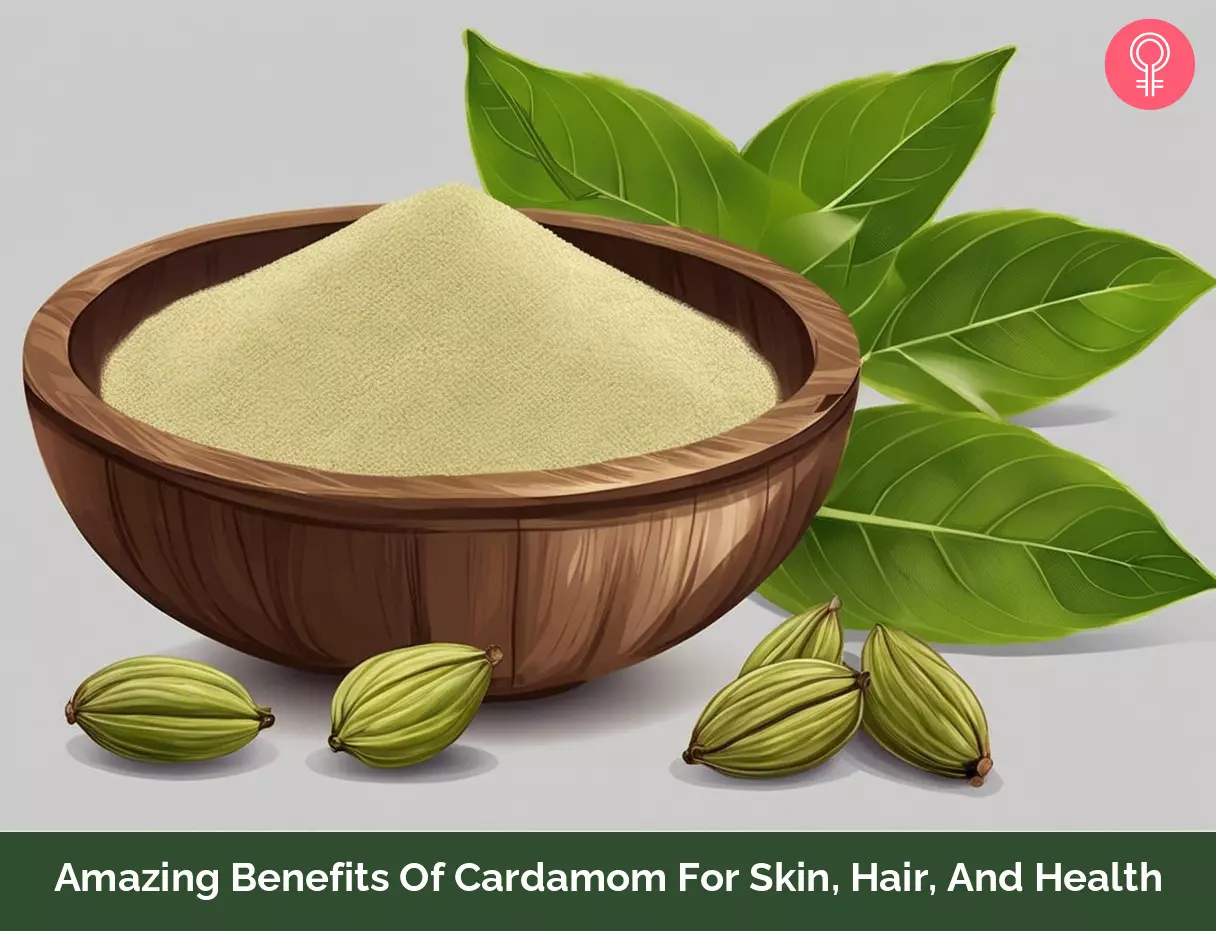
Image: Stable Diffusion/StyleCraze Design Team
Discover the remarkable health benefits of cardamom in this video. Uncover its potential health benefits like improving digestion, reducing inflammation, and boosting your immune system. Check out the video below now!
Personal Experience: Source
StyleCraze's articles are interwoven with authentic personal narratives that provide depth and resonance to our content. Below are the sources of the personal accounts referenced in this article.
i. Cooking with cardamomhttps://cardamomkitchen.blogspot.com/2012/03/when-when-when.html
References
- “Antioxidative effects of the spice cardamom against…“. Chittaranjan National Cancer Institute, Kolkata, India. 2012 September.
- “Protective Effects of Cardamom…“. R.C. Patel Institute of Pharmaceutical Education and Research, Shirpur, India. 2015 November.
- “Digestive stimulant action of spices: A myth or reality?” Central Food Technological Research Institute, Mysore, India. 2003 August.
- “Green and Black Cardamom in a Diet-Induced…“. Victoria University, Australia. 2015 September.
- “What do heart experts eat for dinner?“. Harvard Medical School. 2016 May.
- “Chemopreventive effects of cardamom…“. University of Hail, Saudi Arabia. 2012 June.
- “Inhibition of Lipid Peroxidation and Enhancement…“. Asian Pacific Journal Of Cancer Prevention.
- “Gut modulatory, blood pressure lowering, diuretic and sedative activities of cardamom“. Aga Khan University, Karachi, Pakistan. 2008 February.
- “Cure for depression“. USC Digital Folklore Archives.
- “Green and Black Cardamom in a Diet-Induced…“. Victoria University, Melbourne, Australia.
- “Antimicrobial Activity of Amomum subulatum and Elettaria cardamomum Against Dental Caries Causing Microorganisms” Ethnobotanical Leaflets.
- “Nutrition for Bad Breath“. Glendale Community College.
- “Application of EPR Spectroscopy to Examination…“. Medical University of Silesia in Katowice, Poland. 2013 March.
- “Simultaneous HPLC Determination of 22 Components…“. East India Pharmaceutical Works Limited, Kolkata, India. 2014 January.
- “Histoplasmosis“. University of Maryland Medical Center.
- “Blood pressure lowering, fibrinolysis enhancing and antioxidant activities…“. Medical College, Udaipur, Rajasthan, India. 2009 December.
- “Mitigation of 131-I induced oxidative stress by supplementation of turmeric and green cardamom in thyroid patients“. Department of Biochemistry, Punjab Medical College, Faisalabad, Pakistan. 2022 January.
Read full bio of Mollie Meldahl
- Tom Miller, CPT, is also a certified strength and conditioning specialist (CSCS) with 4 years of experience. He graduated from the University of North Carolina at Chapel Hill and loves writing about health and fitness.
 Tom Miller, CPT, is also a certified strength and conditioning specialist (CSCS) with 4 years of experience. He graduated from the University of North Carolina at Chapel Hill and loves writing about health and fitness.
Tom Miller, CPT, is also a certified strength and conditioning specialist (CSCS) with 4 years of experience. He graduated from the University of North Carolina at Chapel Hill and loves writing about health and fitness. - Pallini Winnifred, RDN, serves over 200 clients in the NYC area. She has a bachelor's degree in Nutrition Science from Stony Brook University and two years of experience in nutrition counseling.
 Pallini Winnifred, RDN, serves over 200 clients in the NYC area. She has a bachelor's degree in Nutrition Science from Stony Brook University and two years of experience in nutrition counseling.
Pallini Winnifred, RDN, serves over 200 clients in the NYC area. She has a bachelor's degree in Nutrition Science from Stony Brook University and two years of experience in nutrition counseling. - Jesse Feder, RDN/LDN, is a Clinical Dietitian at the Memorial Regional Hospital. He is also a certified by the American College of Sports Medicine as a personal trainer (ACSM-CPT) and the National Strength and Conditioning Association as a Certified Strength and Conditioning Specialist (NSCA-CSCS).
 Jesse Feder, RDN/LDN, is a Clinical Dietitian at the Memorial Regional Hospital. He is also a certified by the American College of Sports Medicine as a personal trainer (ACSM-CPT) and the National Strength and Conditioning Association as a Certified Strength and Conditioning Specialist (NSCA-CSCS).
Jesse Feder, RDN/LDN, is a Clinical Dietitian at the Memorial Regional Hospital. He is also a certified by the American College of Sports Medicine as a personal trainer (ACSM-CPT) and the National Strength and Conditioning Association as a Certified Strength and Conditioning Specialist (NSCA-CSCS).
Read full bio of Arshiya Syeda
Read full bio of Aparna Mallampalli









